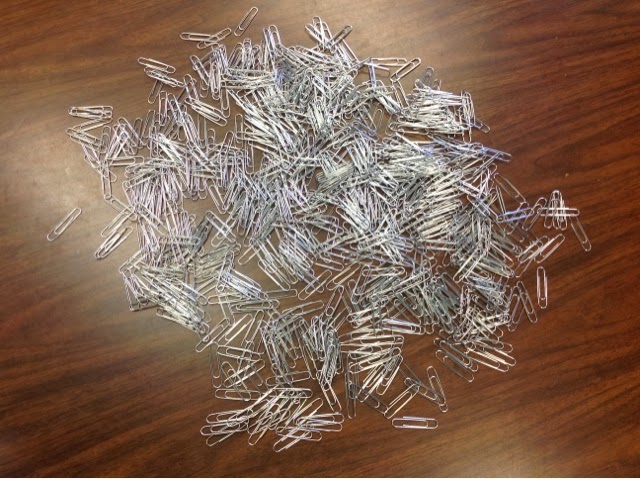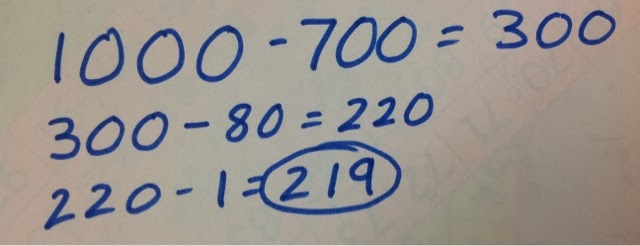New to my posts on estimating and counting routines? Check them out. They are quick and no prep lessons that get at a variety of important number skills and are easily differentiated to meet a variety of needs.
Part 1Part 2Part 3Part 4Part 4.1Part 5I completed this estimation and counting routine with a mixed group of second and third grade students. I wanted to work with numbers within 1000 so we used paper clips for our material. It is something I have plenty of.
 |
| I started by dumping the paper clips on the table and asking kids to make an estimate . These initial estimates are usually way off. At this point they have no point of reference and don't have experience estimating with paper clips. Sometimes I will show them what 10 or 100 looks like first and then I get much better estimates. |
 |
| These are their initial estimates. |
I asked if there was enough for us each to take 100 (5 students and myself). They all agreed that there were. We briefly discussed efficient ways to count to 100 and how we could be sure we were accurate and then got to work counting. At this point, this group has had a lot of prior experiences with these types of routines so this counting job was quick and easy for them.
 |
| This is what the pile looks like after 600 have been taken out. |
I now ask kids to go to the board and adjust their estimate if they would like.
 |
| Adjusted estimates. The orange marker to the side is what we started on next. I asked student C why he thought it was 850. He explained that he thought there were about 250 left in the middle pile plus the 600 we had already taken out. After he said this, other students started seeing how they could have thought deeper about their own estimates. We moved up to student MD and used a missing addend equation to figure out how many MD "thought" were in the middle. When the class came up with 400+107 and asked her if she thought there were 507 in the middle, she said "No! There are way less than that in there, I guess I should have thought of that before I made my estimate." |
 |
| We looked at the other estimates in terms of how much bigger than 600 they were. Some kids realized they made their estimate to large. |
I asked kids if there was enough for us to each take 100. None of the students thought that was possible. There were several suggestions and the number that got the most discussion was 50. We each went to take 50 more being careful to keep the 50 in a separate pile. They quickly realized that we were running out. Folks had between 20 and 42 when we ran out. One student suggested we try 30 so that we wouldn't have to put them all back. We went around the table saying how many we had and how many we needed to make 30 or how many we needed to put back so that we would have 30. This worked very well and quickly we each had 30 paperclips in addition to our pile of 100 and there was one left in the center of the table.
 |
| The final count. Each of the 6 people has a pile of 100 and a pile of 30. There is one paperclip left in the middle of the table. |
I then asked the students to think to themselves about how many we had altogether and give me a signal when they were ready.
 |
| The five students came up with these 4 different numbers. We had a great discussion about which one was right and how we could prove it. The kids made some great connections between counting by 3's and counting by 30's. When students who had the wrong answer tried explaining how they got it, it brought out a great many misconceptions and helped all the students think more deeply about mental addition and skip counting. |
Our final number was 781. Our time was up for the day. The following day we brought this number back to the whole group. I presented them with the context that I really wanted to have 1000 paper clips and needed their help deciding how many more I should order. Students had a few minutes to think to themselves and then shared their ideas with a partner. ALL of this was done mentally. Then they shared different strategies with the whole class. As they were sharing strategies, I wrote down equations that showed their thinking. I was truly impressed with the variety of strategies and mental math that was going on. Here is a peak at some of the ideas. This makes me feel like my work with
problem strings and helping kids develop their own strategies for addition and subtraction is really paying off!
 |
| These students added up from 781 to 1000. |
 |
| These students subtracted from 1000. They started by subtracting 700 and then subtracted 80 and then 1. |
 |
| This student used a fact they know about 100-78=22 to help them figure out 1000-780=220. Then they subtracted 1 more. |
 |
| This student used skip counting to add 100 more twice then 10 more than 9 more. They added 219 in all. |
 |
| These students tried adding 300 but got to much so they subtracted the extra 81. In their words, "if you add 300 and then take 81 back it is the same as adding 219." |
Have you tried estimating and counting routines in your classroom? How about problem strings?














0 Komentar untuk "Estimating and Counting Routines Part 6"